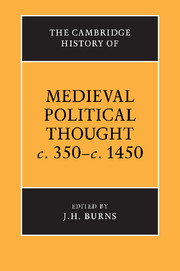Book contents
- Frontmatter
- Introduction
- I Foundations
- II Byzantium
- III Beginnings: c. 350–c. 750
- IV Formation: c. 750–c. 1150
- 8 Introduction: the formation of political thought in the west
- 9 Government, law and society
- 10 Kingship and empire
- 11 Church and papacy
- 12 The twelfth-century renaissance
- V Development: c. 1150–c. 1450
- Conclusion
- Biographies
- Bibliography
- Index of names of persons
- Index of subjects
- References
8 - Introduction: the formation of political thought in the west
from IV - Formation: c. 750–c. 1150
Published online by Cambridge University Press: 28 March 2008
- Frontmatter
- Introduction
- I Foundations
- II Byzantium
- III Beginnings: c. 350–c. 750
- IV Formation: c. 750–c. 1150
- 8 Introduction: the formation of political thought in the west
- 9 Government, law and society
- 10 Kingship and empire
- 11 Church and papacy
- 12 The twelfth-century renaissance
- V Development: c. 1150–c. 1450
- Conclusion
- Biographies
- Bibliography
- Index of names of persons
- Index of subjects
- References
Summary
Western Europe during the four centuries that precede the establishment of the Carolingian monarchy in 751 saw the conversion to Catholic Christianity of the barbarian successor kingdoms within the limits of the western empire and their progressive withdrawal from Byzantium's sphere of influence. Within a short period of about fifty years the Carolingian Franks became masters of all western Christendom excluding the British Isles. With the imperial coronation of Charlemagne in Rome in 800 and with the experience of personal rule on an apparently universal scale the barbarian phase of European history reaches its zenith.
The empire of Charlemagne, the ‘father of Europe’, did not retain its fullest size or its unity for long but it left an enduring memory to the later generations. Its lands were divided in 843 among different members of the Carolingian dynasty although one of the family always carried an imperial title until 924. The ninth century experienced the irruption into north-western Europe of the pagan Vikings, while central Europe became destabilised following invasions by the Magyars until the battle of Lechfeld in 955. The collapse of the Carolingian state in west Francia made way for regional or territorial principalities whose rulers around 900 attempted to exercise the functions nominally still belonging to the Carolingian king. When the last such king died in 987, and Hugh Capet secured election to the throne, there was no hint that the Capetian house would ever come to rule on more than a small local scale.
- Type
- Chapter
- Information
- The Cambridge History of Medieval Political Thought c.350–c.1450 , pp. 155 - 173Publisher: Cambridge University PressPrint publication year: 1988

